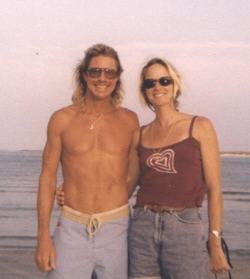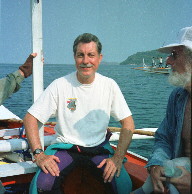 |
Reticulidia suzanneae
Photos courtesy of Mark StricklandFrom the Andaman Sea and the land of gold roofed temples comes another golden beauty. It is only by coincidence that this species name recognizes a person with golden hair, Suzanne Forman, of Phuket, Thailand, a friend and the person making us aware of this beautiful new species. Actually we must give some credit additionally to blonde hubby Mark Strickland who photographed and collected specimens. I'm starting to see a romantic color theme going on here. Mark was previously honored on the Slug Site with the description Halgerda stricklandi in recognition of his efforts in the field. Mark is an excellent photographer of sea slugs as also seen in the BOW presentation of Ceratosoma moloch .
The genus Reticulidia contained two Indo-Pacific species and a single western Atlantic species. The addition of R. suzanneae makes four. R. suzanneae is easily distinguished from the other sympatric Indo-Pacific species, Recticulidia halgerda and R. fungia . The former two are black with yellow-orange dorsal ridges, edged with a white stripe. R. fungia has a wide blue band along mantle margin. R. suzanneae is yellow with a network of sharp, perpendicular ridges. Each ridge is edged with white, and creates irregular pits of various shapes. One or more circular black spots are found at the bottom of each pit. The rhinophores are orange.
Additional photos of R. suzanneae can be found on the Australian Museum Sea Slug Forum, listed under Reticulidia sp. 1 , and seen on page 277 of Helmut Debelius's Indian Ocean Reef Guide , where it is referred to incorrectly as R. halgerda .
Currently the range of this species is limited to several localities in the Phuket Province, Andaman Sea, Thailand, and nothing is known about its prey preferences.
Thanks to Suzanne and Mark for their assistance in providing material necessary to give this beautiful creature a name. Hopefully others will see it and we can learn more about the biology of this species from their observations.
Reference:
Valdes, Angel & David W. Behrens. 2002. Phyllogenetic systematics of Reticulidia Brunckhorst, 1990 (Mollusca, Nudibranchia), with the description of a new species from the tropical Indo-Pacific. Nat. Hist. Mus. Los Angeles Co., Contrib. in Sci. 492: 1-10.
Danville, Calif
May., 2002

|
Suzanne grew up in Los Angeles, where she learned to enjoy big-city life. Much stronger, however, was the love she developed for nature, and the simple joy of being outdoors. A natural athlete, she excelled in virtually every sport she tried, including basketball, distance-running and swimming. After graduating from Stanford University with a degree in Art History, she sold art for several prominent galleries until her natural instincts took over. Suzy wanted to work outdoors, so she became a scuba instructor and taught diving for several years in Maui. Eventually she met Mark there through mutual friends, and later joined him for a dive trip in Thailand in 1990. Suzy & Mark hit it off, and have been together ever since. For nearly eight years they worked together on a live-aboard dive boat, helping divers appreciate Thailand's underwater world. Recently, however, Suzy has taken a leave of absence to raise the couple's pride and joy, a cheerful one-year old boy named Dylan. Suzy was the one who spotted this new species of Reticulidia the first time and pointed them out to Mark. Mark Strickland has had a close relationship with the sea since an early age. Growing up in Florida, he has worked many years as an ocean lifeguard, boat captain, and diving instructor. Mark's passion for underwater photography has led him to many of the world's best diving areas, including Australia, the Caribbean, Galapagos, Indonesia, Papua New Guinea and many other destinations throughout the Indo-Pacific and elsewhere. While each of these areas offered something special, many of Mark's favorite dives are in the vicinity of Phuket, Thailand, where he's been based since 1988. Most of each year, Mark works for Fantasea Divers, serving as Cruise Director / Photo- Pro on their live-aboard vessel, Ocean Rover. An avid marine naturalist, Mark has discovered several new species of nudibranchs, including one that is named for him, Halgerda stricklandi. |
Send Mark and Suzanne mail at Oceanimprs@aol.com
Taxonomic information courtesy of:

David W. Behrens
Author:
Pacific Coast Nudibranchs
Send Dave mail at seachalleng@earthlink.net
|
